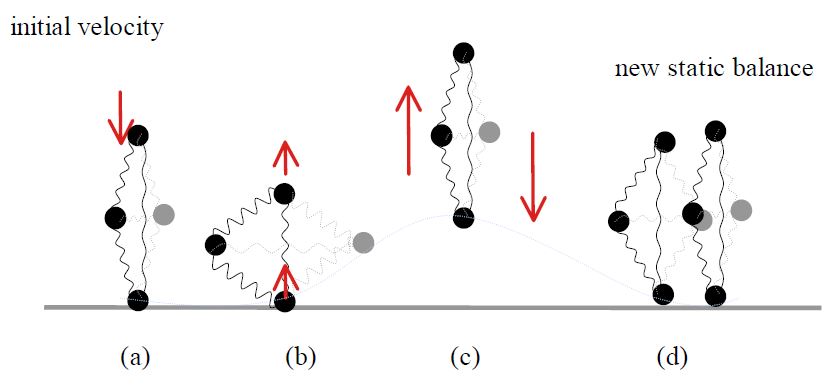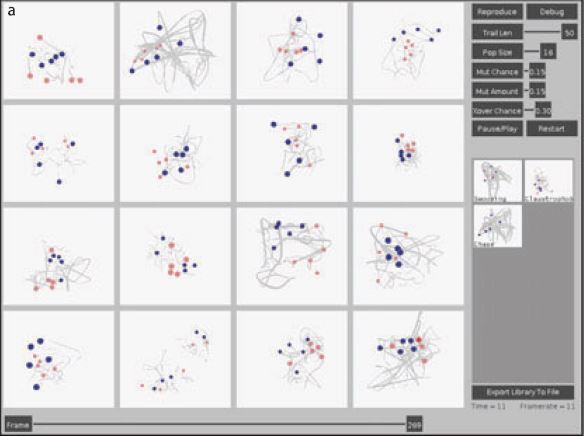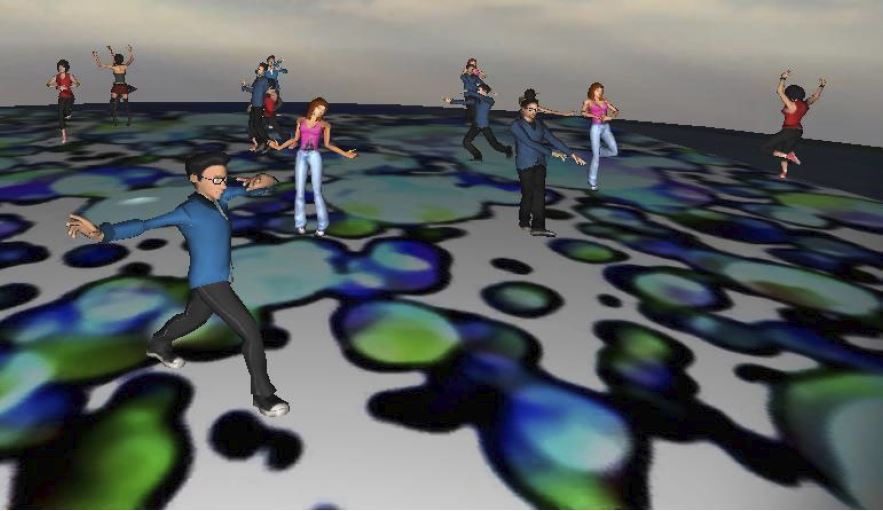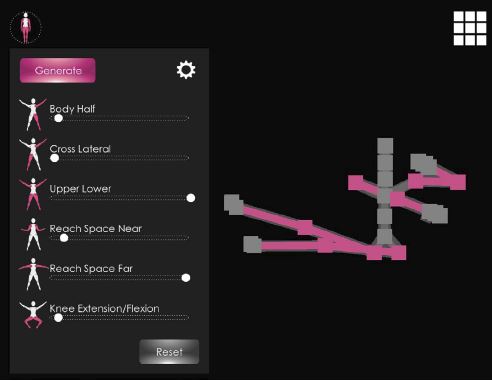The term Generative Art refers to artistic approaches that delegate the creation of an artwork to a partially or fully automated process. While generative processes don’t necessarily have to be realized through technical means, this is by far the most popular approach. For this reason, Generative Dance strongly overlaps with the field of Dance and Technology.
Generative Art is a creative approach that has found applications in several artistic disciplines. Some disciplines have a long tradition of employing formalization and abstraction as elements of artistic thinking and to represent and structure creative processes. This predisposes these disciplines for the adoption of generative methods.
In dance, formalization and abstraction play a less prominent role and their usefulness is more contested. Some of the reasons for this involve dancer’s reliance on tacit knowledge and a preoccupation with the human body as material object and experiential resource, both of which are difficult to formalize. This renders the creative possibilities that Generative Art offers for dance less obvious. Nevertheless, the field of dance has an enthusiastic community of its own that experiments with generative approaches. The following article provides an overview of generative methods that have been developed in the context of dance. Each of these methods is illustrated by several examples.
Randomness
Several generative systems employ random processes as means to generate unexpected and/or novel outputs
One example is a choreographic system that has been developed by Soga and colleagues. The system creates short choreographies by synthesizing the motion of body parts of an artificial dancer and then render them as a 3D animations. A user can manually select motions, after which the system randomly choses additional motions and timings that are compatible with the user’s choice (Ref: Asako Soga, Yuho Yazaki, Bin Umino, and Motoko Hirayama. 2017. Automatic
Synthesizing System of Choreography for Supporting Contemporary Dance
Creation. In Proceedings of the 20th Generative Art Conference).
Another example is an artificial dancer that has been developed by Berman and Valencia. The artificial dancer performs a duet with a human dancer in a piece entitled “AI am here“. The artificial dancer generates its motions by navigating a map of abstract pose representations. This navigation follows a random trajectory. (Ref: Alexander Berman and Valencia James. 2014. Towards a live dance improvisation
between an avatar and a human dancer. In Proceedings of the 2014 International
Workshop on Movement and Computing. 162–165.)
Rules-based Systems
Rule-based systems follow classical computational paradigms. The rules typically take the form of conditional statements and processing steps, the latter of which are executed if the conditional statement evaluates to true. These rules are often deterministic and simple but it is through their sheer number that diverse results can be obtained.
Coleman and Byrne experimented with the relationship between procedural rules and choreographed movements. As a case study, they realised a section entitled “36 Walk” that forms part of a larger performance piece entitled “Echo::system. The section employs a set of rules and numbers that dancers memorize and then use as probabilistic score. (Ref: Grisha Coleman and Daragh Byrne. 2014. 36 Walk: a case study of reciprocity in movement and computation. In Proceedings of the 2014 International Workshop on Movement and Computing. 55–60)
For their performance entitled “Sound Choreography <> Body Code“, Sicchio and McLean, a dancer and a musician, developed two live coding systems, one generating a live score that is interpreted by a dancer, the other creating instructions that are interpreted by a computer to create music. The dance score consists of simple instructions (e.g. right, left, up, down, loop, if) and numbers that are organised in a tree. The dancer prepares a simple movement vocabulary that is used when interpreting the score. The score is continually recalculated and changes in response to frequencies detected in the computer generated music.
Jochum and Derks re-purposed a motorised base of a wheelchair to create a dancing robot that human dancers can improvise with. Several behavioural sketches have been developed for the robot, each of which contains a distinct set of rules with which it responds to the position of a human dancer. Several dancers with different performance traditions (breakdance, physical theatre and modern dance) were invited to improvise with the robot. (Ref: Elizabeth Jochum and Jeroen Derks. 2019. Tonight We Improvise! Real-time tracking for human-robot improvisational dance. In Proceedings of the 6th International Conference on Movement and Computing. 1–11.)
Computer Simulation
The simulation of natural phenomena, especially those that deal with complex systems, offer a promising starting point for creating generative works. These works inherit some of the operational principles of the original phenomena but translate them into digital media.
Hsieh and Luciani developed a physics-based simulation to support choreographers in the creation of dance movements. The authors use the Cordis-Anima dynamics simulation within which they deconstruct a dancing body into a minimal set of essential interactions between masses. The authors then select a basic set of dance movements (rebound, jump, flip, wave). For each of these movements, the define a minimal set and an energy-based principle for initiating, evolving and ending the movement of the masses. (Ref: Chi-Min Hsieh and Annie Luciani. 2005. Generating dance verbs and assisting computer choreography. In Proceedings of the 13th Annual ACM international Conference on Multimedia. 774–782.)

Eisenmann and colleagues extended an existing simulation-based choreographic system that models the alignment principle in choreographer William Forsythe’s counterpoint technique. The extension adds flocking-based steering behaviours. The simulation can be choreographed to change over time by means of a state machine in which each state corresponds to a specific weighting of the forces created by each behaviour. To alleviate the difficulty of finding good parameterisations and weightings for the behaviours, an interactive evolutionary system is used. (Ref: Jonathan Eisenmann, Benjamin Schroeder, Matthew Lewis, and Rick Parent. 2011. Creating choreography with interactive evolutionary algorithms. In European Conference on the Applications of Evolutionary Computation. Springer, 293–302.)

Antunes and Leymarie developed a choreographic system entitled “Vishnu’s dance of life and death”. This system is based on a computational ecosystem. The dancers are agents that populate the artificial ecosystem, have a metabolism and compete for resources. The agents’ needs determine their choice of actions. The ecosystem is translated into a dance performance, with agents born and dying entering and leaving the stage, and the agents’ actions shown as dance movements.(Ref: Rui Filipe Antunes and Frederic Fol Leymarie. 2012. Generative choreography: animating in real-time dancing avatars. In International Conference on Evolutionary and Biologically Inspired Music and Art. Springer, 1–10.).

Artificial Evolution
Artificial Evolution is a popular method for automatically changing the properties of a generative system in order to obtain an output that meets some pre-specified quantitative criteria. Artificial evolution mimics some of the principles of natural evolution such as representing the configuration of a system as genotype, using genetic operations such as mutation and cross-over, and working with populations of individuals that can have off springs to which they pass their genetic makeup.
Carlson and colleagues developed a choreographic support tool entitled Cochoreo that generates dance poses. Poses are created by a Genetic Algorithm that employs an automated fitness function which favours unusual poses. These are poses with asymmetry, uneven reach space, and instable balance. The poses are meant to serve as seed material in a choreographic process and encourage experimentation with new movement material. (Ref: Kristin Carlson, Philippe Pasquier, Herbert H Tsang, Jordon Phillips, Thecla Schiphorst, and Tom Calvert. 2016. Cochoreo: A generative feature in idance-Forms for creating novel keyframe animation for choreography. In Proceedings of the Seventh International Conference on Computational Creativity.)

“Performative Ecologies: Dancers” is a robotic installation developed by Ruairi Glynn. The Dancers in the installation are robots suspended in space by threads and are capable of performing ‘gestures’ through twisting movements. The fitness of the gestures is evaluated as a function of audience attention and is determined by each robot through face tracking. Audience members can directly participate in the evolution by manipulating the robots to record a new gesture. Successful gestures are shared between the robots. (Ref: Ruairi Glynn. 2008. Conversational environments revisited. Emerald Group Publishing Limited.)
Machine-Learning
Machine learning is similar to Artificial Evolution in that it deals with the automated configuration of a system with the purpose of optimising its behaviour for a given task. Unlike Artificial Evolution, Machine Learning doesn’t mimic genetic operations or operate on populations. Instead it employs a mathematical model whose parameters its improves. Some of these models are inspired by how neurons in a brain operate. Machine Learning has recently become immensely popular and has largely displaced Artificial Evolution.
Luka and Louise Crnkovic-Friis have developed a machine-learning based system entitled Chor-RNN for generating synthetic movements for an artificial dancer. Chor-RNN employs a recurrent neural network that is trained on motion capture data. Chor-RNN is meant to facilitate a human choreographer’s creative process in several ways. Two examples include a collaborative choreography and a mutually interpreted choreography. In the collaborative choreography, the system and human take turns in continuing each other’s movements. In the mutually interpreted choreography, the system and human take turns in interpreting each others movements. (Ref: Luka Crnkovic-Friis and Louise Crnkovic-Friis. 2016. Generative choreography using deep learning. arXiv preprint arXiv:1605.06921 (2016).)
Li and colleagues developed a machine-learning based model that translates music into dance movements. This model has been trained on dance videos found on Youtube from which poses were extracted. The model employs two transformer architectures, one for capturing a sequence of dance poses and one for capturing musical context. This information is combined to predict the next dance pose. (Ref: Jiaman Li, Yihang Yin, Hang Chu, Yi Zhou, Tingwu Wang, Sanja Fidler, and Hao
Li. 2020. Learning to Generate Diverse Dance Motions with Transformer. arXiv
preprint arXiv:2008.08171 (2020).)